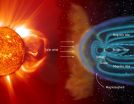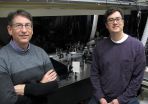The fine-tuning of human color perception
2014-12-18
(Press-News.org) The evolution of trichromatic color vision in humans occurred by first switching from the ability to detect UV light to blue light (between 80-30 MYA) and then by adding green-sensitivity (between 45-30 MYA) to the preexisting red-sensitivity in the vertebrate ancestor. The detailed molecular and functional changes of the human color vision have been revealed by Shozo Yokoyama et al. Emory University and is published in the journal PLOS Genetics.
The molecular basis of functional differentiation is a fundamental question in biology. To fully appreciate how these changes are generated, it is necessary to evaluate the relationship between genes and functions. This is a difficult task because new mutations can produce different functional changes when they occur with different preexisting mutations, causing complex non-additive interactions.
The blue-sensitive visual pigment in human evolved from the UV-sensitive pigment in the ancient Boreoeutherian ancestor by seven mutations. There are 5,040 possible evolutionary paths connecting them. The team examined experimentally the genetic composition and color perception of the visual pigment at every evolutionary step of all 5,040 trajectories. They found that 4,008 trajectories are terminated prematurely by containing a dehydrated nonfunctional pigment. Eight most likely trajectories reveal that the blue-sensitivity evolved gradually almost exclusively by non-additive interactions among the seven mutations.
These analyses demonstrates that the historical sequence of change is critical to our understanding of molecular evolution and emphasizes that genetic engineering of ancestral molecules is the key to decode the complex interactions of mutations within a protein and their effects on functional change.
INFORMATION:
ELSE PRESS RELEASES FROM THIS DATE:
2014-12-18
CAMBRIDGE, MA -- For decades, neuroscientists have been trying to design computer networks that can mimic visual skills such as recognizing objects, which the human brain does very accurately and quickly.
Until now, no computer model has been able to match the primate brain at visual object recognition during a brief glance. However, a new study from MIT neuroscientists has found that one of the latest generation of these so-called "deep neural networks" matches the primate brain.
Because these networks are based on neuroscientists' current understanding of how the ...
2014-12-18
A University of Southampton researcher has helped solve a long standing space mystery - the origin of the 'theta aurora'.
Auroras are the most visible manifestation of the Sun's effect on Earth. They are seen as colourful displays in the night sky, known as the Northern or Southern Lights. They are caused by the solar wind, a stream of plasma - electrically charged atomic particles - carrying its own magnetic field, interacting with the earth's magnetic field.
Normally, the main region for this impressive display is the 'auroral oval', which lies at around 65-70 degrees ...
2014-12-18
PROVIDENCE, R.I. - Where you live affects the type of bacteria that cause bloodstream infections, according to researchers at Rhode Island Hospital and an international team of investigators. The closer you live to the equator, the greater the likelihood of a bloodstream infection caused by a group of bacteria called Gram-negative bacteria, which thrive in warm and moist environments, compared to another group of bacteria referred to as Gram-positive bacteria. The study also found that the proportion of a country's GDP spent on health care impacted the type of bacteria ...
2014-12-18
DALLAS - Dec. 18, 2014 - Retroviruses are best known for causing contagious scourges such as AIDS, or more sporadically, cancer.
But researchers at UT Southwestern Medical Center and Karolinska Institutet in Stockholm, Sweden, found that endogenous retroviruses (ERV) also play a critical role in the body's immune defense against common bacterial and viral pathogens.
"Most scientists have become used to the view that retroviruses are generally harmful," said Nobel Laureate Dr. Bruce Beutler, Professor and Director of UT Southwestern's Center for the Genetics of Host ...
2014-12-18
Primates visually recognise and determine the category of an object even at a brief glance, and to date, this behaviour has been unmatched by artificial systems. A study publishing this week in PLOS Computational Biology has found that the latest artificial "deep neural network" performs as well as the primate brain at object recognition.
Charles Cadieu and colleagues from MIT measured the brain's object recognition ability by implanting arrays of electrodes in the inferior temporal cortex of macaques. This allowed the researchers to see the neural representation -- the ...
2014-12-18
A definitive geological timeline shows that a series of massive volcanic explosions 66 million years ago spewed enormous amounts of climate-altering gases into the atmosphere immediately before and during the extinction event that claimed Earth's non-avian dinosaurs, according to new research from Princeton University.
A primeval volcanic range in western India known as the Deccan Traps, which were once three times larger than France, began its main phase of eruptions roughly 250,000 years before the Cretaceous-Paleogene, or K-Pg, extinction event, the researchers report ...
2014-12-18
(Boston)--Dr. Deborah Anderson from Boston University School of Medicine (BUSM) and her colleagues are challenging dogma about the transmission of the human immunodeficiency virus type 1 (HIV-1). Most research has focused on infection by free viral particles, while this group proposes that HIV is also transmitted by infected cells. While inside cells, HIV is protected from antibodies and other antiviral factors, and cell-to-cell virus transmission occurs very efficiently through intercellular synapses. The Journal of Infectious Diseases (JID) has devoted their December ...
2014-12-18
EUGENE, Ore. -- Dec. 18, 2014 -- Four pulses of laser light on nanoparticle photocells in a University of Oregon spectroscopy experiment has opened a window on how captured sunlight can be converted into electricity.
The work, which potentially could inspire devices with improved efficiency in solar energy conversion, was performed on photocells that used lead-sulfide quantum dots as photoactive semiconductor material. The research is detailed in a paper placed online by the journal Nature Communications.
In the process studied, each single photon, or particle of ...
2014-12-18
Washington, DC--As people in developing nations relocate from rural areas to cities, the increased stress is affecting their hormone levels and making them more susceptible to diabetes and other metabolic disorders, according to a new study published in the Endocrine Society's Journal of Clinical Endocrinology & Metabolism (JCEM).
About 387 million people worldwide have diabetes, and 77 percent of them live in low- and middle-income countries, according to the International Diabetes Federation. In the Middle East and north Africa, one in 10 adults has diabetes.
One ...
2014-12-18
Washington, DC--Women who experience moderate to severe hot flashes and night sweats during menopause tend to have lower bone mineral density and higher rates of hip fracture than peers who do not have menopausal symptoms, according to a new study published in the Endocrine Society's Journal of Clinical Endocrinology & Metabolism.
Menopause is the life stage when a woman's ovaries stop producing hormones and her menstrual periods stop. About 60 percent of women experience hot flashes, which can last for several years.
Postmenopausal women face a greater risk of developing ...
LAST 30 PRESS RELEASES:
[Press-News.org] The fine-tuning of human color perception


